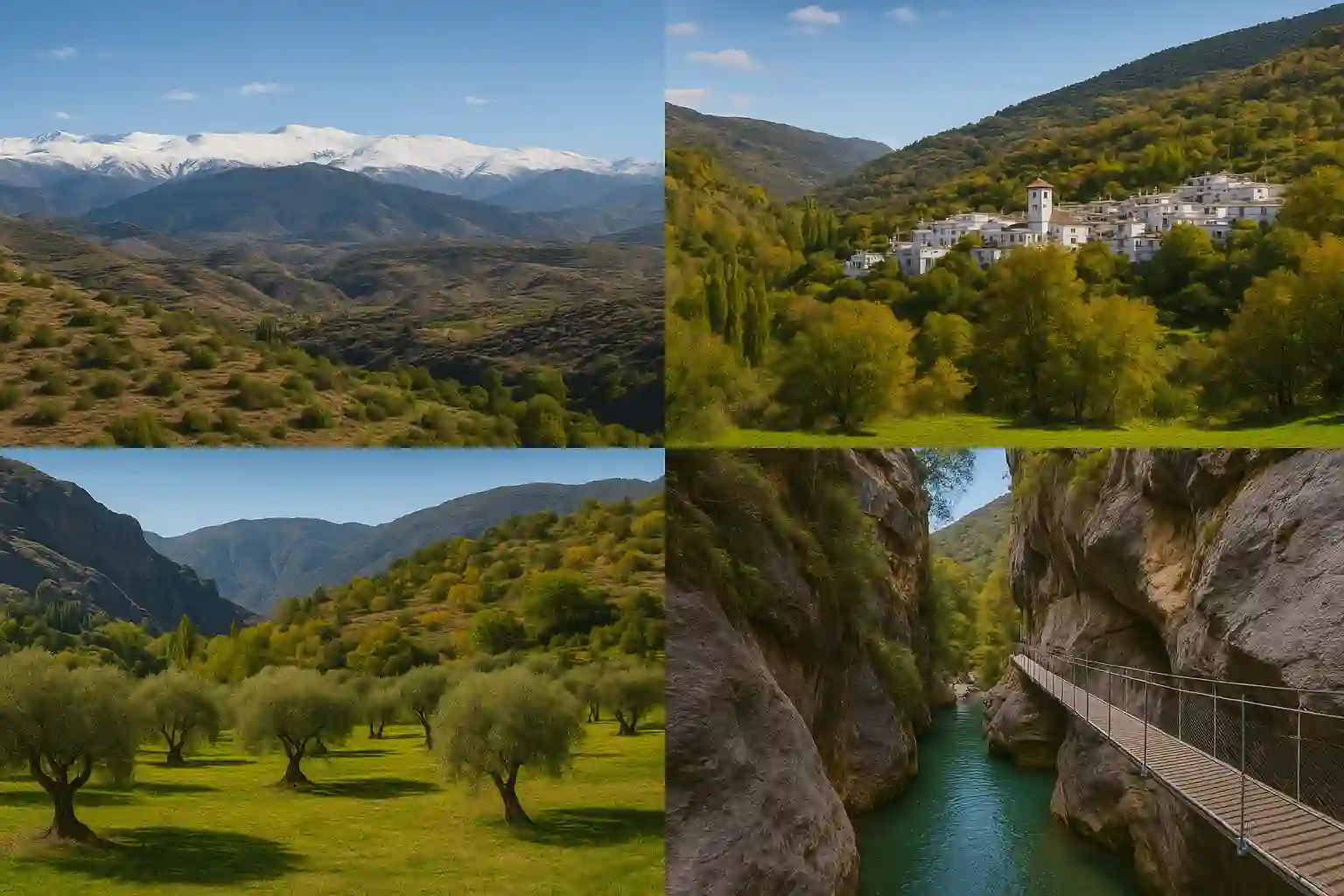Granada Nature & Surroundings – Eco-Journeys, Mountains & Day Trips

1. The High-Mountain Sanctuary: Sierra Nevada
Less than an hour’s drive from Granada, the Sierra Nevada massif rises to over 3 000 m altitude and has been declared a biosphere reserve for its exceptional biodiversity. :contentReference[oaicite:4]{index=4} With dramatic changes in altitude, the vegetation shifts from oak and pine forests to alpine meadows and glacial lagoons — a rarity in southern Europe. :contentReference[oaicite:5]{index=5} The area supports more than 2 000 plant species, including 66 endemics, and a rich fauna of high-mountain birds and mammals. :contentReference[oaicite:6]{index=6}
For the responsible traveller, take one of the marked trails from Pradollano or Trevélez — ensure you carry water, layered clothes and pick up the local conservation rules. Consider also the idea of sustainable transport: many routes start from the bus station or organised eco-shuttles that reduce individual car use.
2. River Gorges & Hanging Bridges: Los Cahorros de Monachil
Only about 20 minutes from Granada, the gorge of Los Cahorros de Monachil offers a dramatic escape: narrow cliffs, fast-flowing waters and several suspension bridges make it a favourite for day-hikers. :contentReference[oaicite:8]{index=8} The loop trail covers roughly 6–8 km with an easy to moderate grade, perfect for a morning or afternoon out of town. :contentReference[oaicite:9]{index=9}
Arrive early to avoid the crowds, wear good grip-shoes, and respect the natural environment: no litter, stay on path, keep dogs leashed. On the banks of the Monachil River you’ll see how water has carved rock arches, created caves and inserted micro-habitats that support rare ferns and mosses — an ecological micro-wonder near the city. :contentReference[oaicite:10]{index=10}
3. White Villages & Traditional Agriculture: La Alpujarra
South of the Sierra Nevada lies La Alpujarra, a region of terraced hills, olive groves and white-washed villages that have preserved farming practices for centuries. :contentReference[oaicite:12]{index=12} A day-trip from Granada can take you through Pampaneira, Bubión and Capileira — villages where you’ll find community-run cooperatives, organic produce and locals who still shepherd goats on high slopes.
Travel slowly: stop for a midday snack of honey-drizzled almonds, visit a solar-powered craft workshop, and walk a path along the Rio Poqueira for soft terrain and rewarding views. This is nature tourism with roots, not high speed.
4. Eco-Journeys & Day Trips from Granada
- Sierra Nevada Highlands – Morning bus or eco-shuttle to Pradollano, hike to Mirador de Trevélez or Lagunas de la Caldera; return by afternoon.
- Los Cahorros Gorge – After breakfast in Granada, drive or take bus to Monachil, complete loop walk, stop for lunch, return by early evening.
- La Alpujarra Villages – Full-day trip: pick up those white villages, artisan markets, short nature walk, and local gastronomic stop – back in Granada before sunset.
Each of these trips can be done without overnight stays, letting you base yourself in Granada and still discover the wild, quieter side of Andalusia. Choose early departures, pack a small day-rucksack, and embrace off-peak seasons for a more mindful experience.
5. Conservation & Sustainable Travel
The landscape around Granada is fragile. High-mountain zones, riparian forests and terraced farmland are vulnerable to erosion, visitor pressure and climate change. In the Sierra Nevada natural park you’ll find clear guidance on staying on trails and respecting flora and fauna. :contentReference[oaicite:13]{index=13}
Tips for low-impact travel:
- Use public transport, shared shuttles or car-pool to trailheads.
- Stay on designated paths; avoid stepping on delicate alpine plants or mosses.
- Carry out all waste and keep water-use minimal in dry months.
- Support local economy: buy from village cooperatives, stay in small guesthouses, favour solar-powered workshops.
6. Practical Info: What to Bring & When to Go
For visits from Granada:
- Footwear: good hiking shoes, non-slip soles (especially for gorge walks).
- Clothes: layers (mountain air cools fast), rain-shell, sun-hat and sunscreen.
- Transport: bus or shuttle from Granada city centre to Monachil, Sierra Nevada or Alpujarra; book ahead in high-season.
- Seasonal Notes: Spring and autumn offer best light and fewer crowds. Summer is hot in lower zones; winter requires snow gear if heading high.
In the hills and valleys around Granada, nature teaches stillness, time and continuity. These day-trips are not just breaks — they are invitations to slow down, respect what is wild and return to town with deeper awareness.
